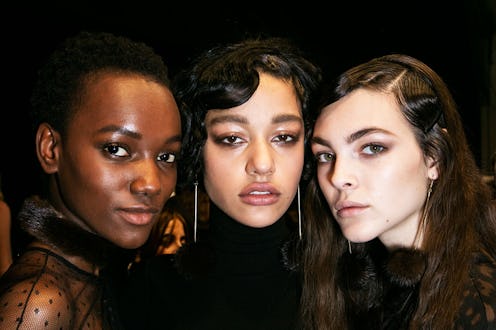Do you ever find yourself at the beauty counter re-reading a foundation’s shade description, then scratching your head trying to figure out if you’re warm honey or cool beige? While it seems like an easy question to answer, many of us struggle with knowing our exact skin tone and undertone. To make your next shopping trip a little easier, we’ve tapped expert makeup artists Fiona Stiles of Fiona Stiles Beauty, Sonia Kashuk of Sonia Kashuk Beauty and Vanessa Eckels of Hourglass for tips on locking down your true hue.
Find Your Skin Tone
"Undertone is very important as it's the deal breaker when choosing the right foundation like my Undetectable Foundation Stick. For example, a person with a fair complexion can be cool, warm, olive or neutral, so just because a foundation is 'light' or 'fair' does not mean it will work. This stands true for all complexion tones."
—Sonia Kashuk, Founder of Sonia Kashuk Beauty
"Undertones can be yellow, red, olive or pink. Generally, very pale or freckly women have a pink undertone. Latina, Middle Eastern, Mediterranean and light-skinned African-American women have olive undertones, darker-skinned African-American women can have a red undertone (although it can also have a bit more olive/green in it) and Asian women have more of a yellow undertone. Of course, there are many exceptions and endless variations, so this is just a general guideline."
—Fiona Stiles, Founder of Fiona Stiles Beauty
"The best way to determine your undertones is to go by your veins. Look at the underside of your forearms in natural sunlight. Generally, if your veins are blue/purple, you have cool undertones. Yellow or green veins are a sign of warm undertones. If you have veins with both blue and green tones, you are neutral. Neutral is the happy medium between warm and cool and is definitely a true undertone."
—Sonia Kashuk
"To find the best makeup shade match, I first identify the undertones. Next, I select the foundation based on skin type. If their skin is on the dry side, I reach for the Hourglass Illusion Hyaluronic Skin Tint. I'll pick three shades that I feel will be a good match, then I test each on three key areas—the neck/jawline, the cheek and the forehead. This step is important since the shade of the skin varies at different points of the face. When selecting concealer, I'll try to match specifically to the area of the face where the product will be applied."
—Vanessa Eckels, Senior Makeup Artist at Hourglass
"Open shade is the best for testing colors. It's bright, but not so bright that you can't clearly see the color. I like to get near a window or an open door and check in a mirror there. Blend it out to see if it matches. Color can change when it's thinned out versus having a thick swipe on the skin."
—Fiona Stiles
"I feel that color-matching makeup is a step in the right direction but not always perfect. The readings can vary, as different areas of the face can be lighter or darker. I think that while they might help you gauge what types of colors to look at, it's best to use your eyes to determine what feels right for you."
—Vanessa Eckels
"It's best to have two shades of foundation that you can mix throughout the seasons, such as the Fiona Stiles Matte Finish Foundation Concentrate. This way, you can add a bit more warmth for the summer or cool the shade down for the winter. Mix a little in the palm of your hand and see where you land. Focus on testing and blending the shade in the center of your face, then add a drop of lighter or darker, depending on which end of the spectrum you need to bump up."
—Fiona Stiles
